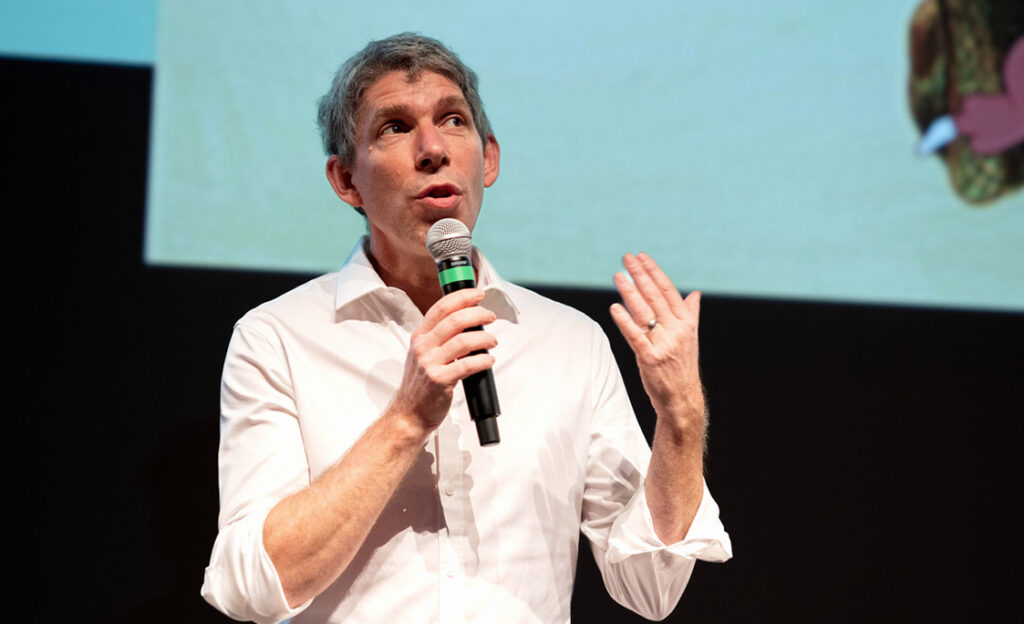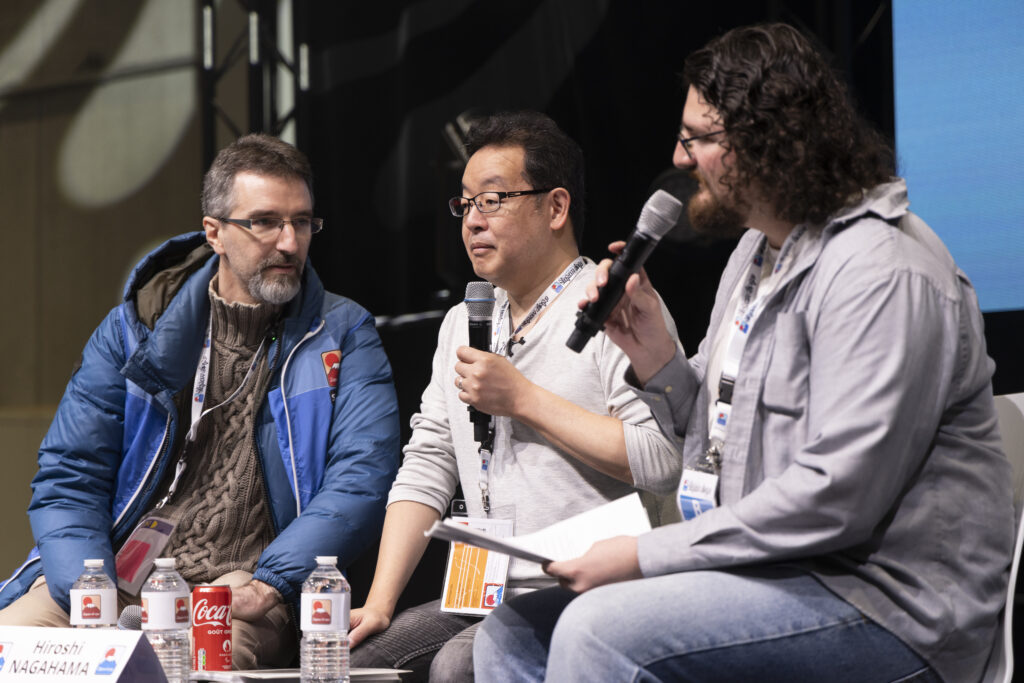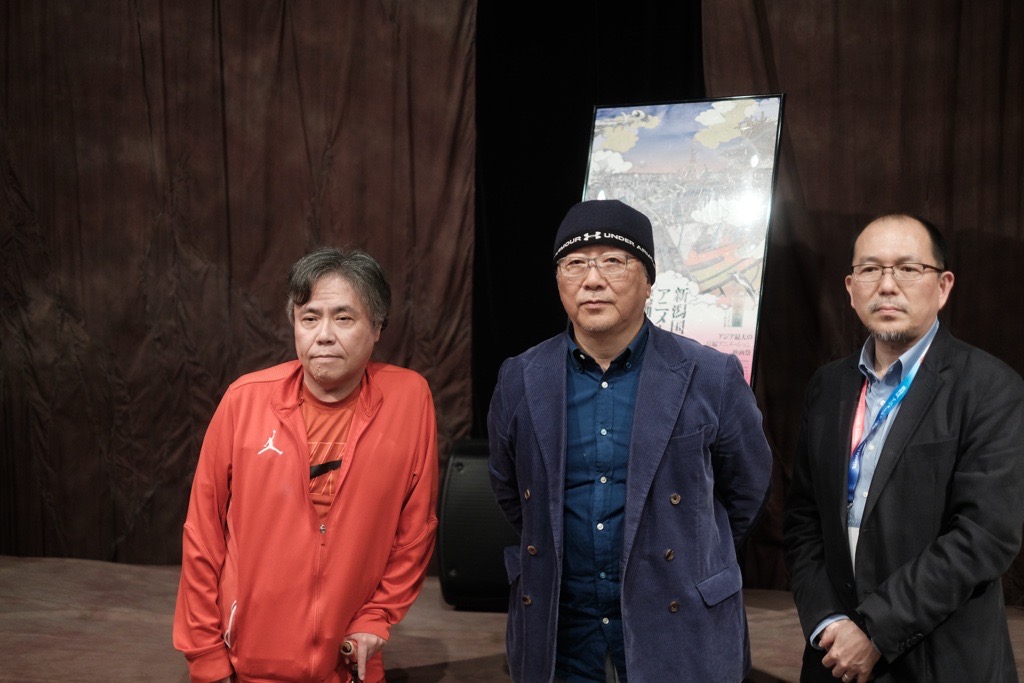French animation studio La Cachette, created in 2013, has in recent years become a presence that animation fans worldwide can’t ignore. After their first viral short, Kairos, they have become famous for their work on the 2019 series Primal, for which they have done all the animation. On March 2, 2022, the three creators of the studio, Ulysse Malassagne, Julien Chheng and Ousama Bouacheria, held a panel in Paris at the Forum des Images theater. There, they recounted the history and evolution of their studio, and have teased some of their future projects.
Like our content? Feel free to support us on Ko-Fi!
The three men first met at the Gobelins school of animation in Paris. They were brought together by their love of Japanese animation and their common desire to explore the potential of 2D animation at a time when 3D was very popular and seen as the only career opportunity. As a reaction against all their teachers telling them to make their graduation films in 3DCG, most of the students in their class instead chose to use 2D.
It is therefore in 2010 that, alongside Nuno Alves-Rodriguez, Aymeric Kevin, Sébastien Hary, and Franck Monier, they released their graduation film: Le Royaume (The Kingdom), the fun and vibrant story of a king building a castle in the woods with the help of the local beavers.
The short was very promising, and all its artists wanted to keep working together, but first they all felt that they needed to acquire some experience in the “real” animation industry. Their paths diverged for some time, but the experiences they gathered encouraged them to create their own place.
First, Chheng was scouted for the Talent Development Program of studio Disney’s design division, which he happily joined. There, he attended the team’s “inspiration days”: each Friday, the artists would gather and watch everything that had come out in animation during the past week to look for animation. Chheng then realized that even those prestigious US-based artists were watching what was made in Europe, including graduation shorts such as his own.
As for Bouacheria, he had also gone through the experience of working outside of France: just before The Royaume, in 2009, he got an internship at the Japanese anime studio Satelight thanks to fellow French animator Thomas Romain. There, he had the opportunity to do layout work on the series Basquash! wich welcomed many other French artists such as Romain himself, art director and designer Antoine Birot or animator Eddie Mehong. Bouacheria quickly realized he wouldn’t stay there for long: “I didn’t want to die doing what I love,” he said.
Finally, Malassagne remained in France as an animator on some projects – including Ernest & Célestine in 2012 alongside Chheng – but he also looked outside of animation and started doing his own comics, such as Kairos, published by studio Ankama.
During those years, the three of them kept seeing each other and shared the frustration of “just being cogs in a big machine.” It is out of that feeling that La Cachette was born, first as a small collective of freelance artists.
During the panel, we also got the secret reason for the studio’s name – La Cachette, i.e., hiding place or hideout. One of Malassagne’s friends owned a small studio “hidden” somewhere in Paris, which he lent to the animators, who had to completely renovate it.
In 2013, this small collective released their first work: Kairos, an animated trailer for Malassagne’s comic – which was just a passion project and wasn’t meant to promote an animated adaptation of the comic. They had zero money, and all the artists on it were friends who agreed to help out.
The short quickly went viral thanks to websites like Catsuka and Cartoon Brew, which helped La Cachette to get noticed. But the situation was very different in 2013: as they said, “there were no platforms like there are today, only ads funded 2d animation back then.”
The studio therefore spent some time doing commissioned work for advertising – which they have never shared or shown before; we had the opportunity of seeing one during the panel; before their first major commercial gig: the 2D dream sequences of the French 3DCG movie Mune in 2014.
They had the opportunity to work on the movie because Bouacheria was already working on the production as a storyboarder; when the studio ran out of budget, La Cachette was contracted to do some cheaper 2D animation – they were in charge of 6 minutes of animation, which they did in 6 months.
This was a key moment in La Cachette’s history. Under the influence of Malassagne and Chheng’s work on Ernest & Célestine, it was there that they really developed their visual identity: digital 2D animation that replicates the look and feel of hand-drawn animation, with thick, “open” linework and expressive movement. It’s also at this point that the collective became a real legal entity. This changed the organization of the group, as Chheng, Malassagne and Bouacheria were now producers and organizers rather than just main animators on their own personal projects. This led them to adopt their own pipeline, very different from that of other French studios: following the Japanese example, they standardized production with a distinct hierarchy centered on the animation director – with Antoine Antin being the first in the position in La Cachette. Bouacheria talked in a bit more detail about this system in an interview with the French association Fransujin Connection:
“Generally, in France, the methods vary according to each production and each studio has its own pipeline. A movie isn’t produced the same way as a music video or a TV episode. The Japanese pipeline is interesting because, whatever the project is, it remains the same. […] Generally, you gain both time and quality. […] It’s a good way to control the production in detail, whether it’s in terms of money or time.”
Following Mune, La Cachette worked on various projects, notably for video game companies. For example, they did a League of Legends WorldCup opening sequence. These were all important experiences in order to understand how a wide-scale production pipeline works.
It’s at this moment that Blur Studio, a US-based CG and SFX company, contacted La Cachette for what they described as a “Moebius-like omnibus movie” – which ended up being sold to Netflix and became Love, Death & Robots. La Cachette was in charge of episode 5, Sucker of Souls, the only full-2D entry in the series. It was La Cachette’s first “narrative-driven, cinematographic and adult” project. This was important for them, as narrative-driven animation was always something they had aspired to.
The studio enjoyed more freedom than ever: they were free to do as they pleased with the designs, which they felt was essential to their work. As they said, “when you have control over the designs, you can control the entire process even if you don’t actually direct.”
However, there were some troubles during the production, as La Cachette tried to impose its own Japan-inspired pipeline. For example, they specifically asked that the director of the short be able to draw so that they would directly make their corrections on the drawings they received rather than just doing annotations. There were also some issues over the “fluidity” of the animation as La Cachette uses limited framerates, to which US artists and producers weren’t accustomed. Despite all this, it was a decisive moment: the anthology was Netflix’s entry into the animation business and gave La Cachette worldwide exposure.
During the production of Sucker of Souls, La Cachette received a mail from legendary US director Genndy Tartakovsky, the one behind many iconic Cartoon Network series such as Dexter’s Laboratory and Samurai Jack. He had seen Mune at the Annecy International Animation Film Festival and, after looking into La Cachette, he wanted them to do the pilot of his next project.
Chheng, Bouasseria, and Malassagne were very honored to receive this proposal, but they weren’t convinced at first: they didn’t believe Tartakovsky’s minimalist style and US/cartoon-inspired approach was suited for them, and at the time, animation series had very low budgets, too low for La Cachette’s high-quality animation. But as soon as Tartakovsky sent them his animatics – over which he added his own narration and sound effects, as he often does – they were sold on it. The project would become Primal, a unique, adult, and very ambitious series.
From that point forward, things moved very fast. La Cachette immediately started doing animation tests and had completed the pilot’s animation in 3 months. Tartakovsky said that he was “going through a second youth” as he never had the opportunity to directly correct the animation the way La Cachette encouraged him to do.
The Primal pilot also represented the studio’s new maturity: many animators who had until then only been assistants did their first key animation. For the animation, artists had to do their own roughs and cleanups for entire shots, which helped them develop their skills and be self-sufficient and able to plan out things by themselves.
In the midst of the pilot’s production, it was decided that La Cachette wouldn’t do just half of Primal but the entire show. The main worry was whether or not they’d have enough time to do things how they wanted, but Tartakovsky pushed the case to the sponsors so that the production schedule would be as good as possible.
Primal was a huge success and even won an Emmy Award. Thanks to the studio’s growth, its creators decided it was finally time to start working on their personal projects and stop subcontracting for others.
The first of these projects is Malassagne’s Le Collège Noir (The Black School), an adaptation from one of his comics. This TV series project takes heavy inspiration from Malassagne’s youth in the Cantal region of France. As he said, he was inspired by Japanese artists and their ability to take their own folklore and give it a modern twist. He wants to do this with France’s own regional folklore.
As of now, the creation and development are over: the studio released the pilot, solo animated by Malassagne, just a few weeks ago. They are now looking for sponsors and distributors to begin the production in earnest.
Then we have Bouacheria’s project, which would be a feature film titled Mehdi, Avis de Passage. It, too, takes inspiration from his personal experience as a postman before he joined the Gobelins school. Bouacheria wants to have a movie taking place in the suburbs of Paris that has a more positive outlook than the usually negative perspective that one can see in French films.
The search for distributors is struggling, as it’s hard to get them to put money on an animated project that’s entirely slice-of-life, with no fantastic dimension. As the pilot shows, the animation would be very cartoony, but the art direction is rather realistic, as the real places in the suburbs are very recognizable for those who know them.
Finally, there’s Chheng’s project: Muyi, a fantasy movie that would take inspiration from Chinese folklore. This is a very ambitious project that he’s had in mind for a long time: the first teaser was shown at the Cartoon Movie festival in 2020.
However, Chheng has struggled to find the right ideas for the scenario and doesn’t want to overlap with his colleague’s projects. That’s why he has accepted to co-direct Ernest & Célestine 2, produced by studio Folivari. La Cachette will also provide some animation, something we had previously talked about on Twitter. It is a very symbolic project: we’ve mentioned the first movie multiple times already; it was a very important work for many of La Cachette’s artists. The movie will be released in France on December 14th, 2022.
That’s not all, as the three men said that their collaboration with Tartakosvky is not over: they remained very vague but hinted at two new projects, one related to Primal – maybe a sequel? And another, “even more ambitious” one, as they said.
La Cachette is a fascinating studio for multiple reasons. The first is, of course, the quality and inventivity of their work: even when they were a small structure, their use of 2d animation technique has been outstanding. In both their distinct visual style and production pipeline, they represent a bridge between Japanese inspiration and the more classical Western tradition of animation. There’s also the fact that La Cachette’s evolution is very symptomatic of the evolution of animation as a whole, both as a technique used by artists, and as a genre marketed and sold by producers and distributors. Indeed, La Cachette’s growth can largely be attributed to actors from outside the studio and their own online – and therefore worldwide – presence: websites like Catsuka and Cartoon Brew, but also platforms such as Netflix. Of course, they are very different entities with different roles and interests. Despite their difference, they have all participated in the worldwide boom of animation – especially 2d – that we’ve been witnessing recently. Considering all the exciting projects that they’ve announced, we can be confident that La Cachette will remain at the center of this boom, both in the domestic and international markets.
Like our content? Feel free to support us on Ko-Fi!
You might also be interested in
Benoît Chieux, a career in French animation [Carrefour du Cinéma d’Animation 2023]
Aside from the world-famous Annecy Festival, many smaller animation-related events take place in France over the years. One of the most interesting ones is the Carrefour du Cinéma d’Animation (Crossroads of Animation Film), held in Paris in late November. In 2023,...
Directing Mushishi and other spiraling stories – Hiroshi Nagahama and Uki Satake [Panels at Japan Expo Orléans 2023]
Last October, director Hiroshi Nagahama (Mushishi, The Reflection) and voice actress Uki Satake (QT in Space Dandy) were invited to Japan Expo Orléans, an event of a much smaller scale than the main event they organized in Paris. I was offered to host two of his...
Akira stories – Katsuhiro Otomo and Hiroyuki Kitakubo talk at Niigata International Animation Film Festival 2023
Among the many events taking place during the first Niigata International Animation Film Festival was a Katsuhiro Otomo retrospective, held to celebrate the 45th anniversary of Akira and to accompany the release of Otomo’s Complete Works. All of Otomo’s animated...





Trackbacks/Pingbacks